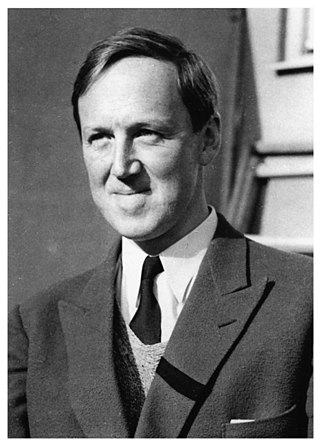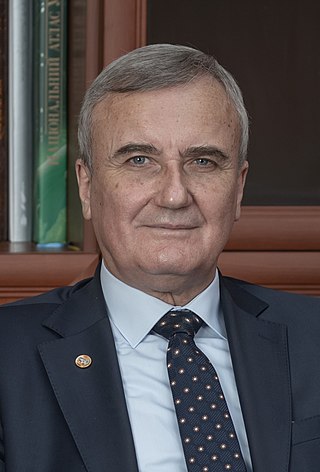
A physicist is a scientist who specializes in the field of physics, which encompasses the interactions of matter and energy at all length and time scales in the physical universe. Physicists generally are interested in the root or ultimate causes of phenomena, and usually frame their understanding in mathematical terms. They work across a wide range of research fields, spanning all length scales: from sub-atomic and particle physics, through biological physics, to cosmological length scales encompassing the universe as a whole. The field generally includes two types of physicists: experimental physicists who specialize in the observation of natural phenomena and the development and analysis of experiments, and theoretical physicists who specialize in mathematical modeling of physical systems to rationalize, explain and predict natural phenomena.

Hannes Olof Gösta Alfvén was a Swedish electrical engineer, plasma physicist and winner of the 1970 Nobel Prize in Physics for his work on magnetohydrodynamics (MHD). He described the class of MHD waves now known as Alfvén waves. He was originally trained as an electrical power engineer and later moved to research and teaching in the fields of plasma physics and electrical engineering. Alfvén made many contributions to plasma physics, including theories describing the behavior of aurorae, the Van Allen radiation belts, the effect of magnetic storms on the Earth's magnetic field, the terrestrial magnetosphere, and the dynamics of plasmas in the Milky Way galaxy.

Yang Chen-Ning or Chen-Ning Yang, also known as C. N. Yang or by the English name Frank Yang, is a Chinese theoretical physicist who made significant contributions to statistical mechanics, integrable systems, gauge theory, and both particle physics and condensed matter physics. He and Tsung-Dao Lee received the 1957 Nobel Prize in Physics for their work on parity non-conservation of weak interaction. The two proposed that the conservation of parity, a physical law observed to hold in all other physical processes, is violated in the so-called weak nuclear reactions, those nuclear processes that result in the emission of beta or alpha particles. Yang is also well known for his collaboration with Robert Mills in developing non-abelian gauge theory, widely known as the Yang–Mills theory.

The University of Science and Technology of China (USTC) is a public university in Hefei, China. It is affiliated with the Chinese Academy of Sciences, and co-funded by the Chinese Academy of Sciences, the Ministry of Education of China, and the Anhui Provincial Government. It is part of Project 211, Project 985, and the Double First-Class Construction.

The Experimental Advanced Superconducting Tokamak (EAST), also known as HT-7U, is an experimental superconducting tokamak magnetic fusion energy reactor in Hefei, China. Operated by the Hefei Institutes of Physical Science conducting its experiments for the Chinese Academy of Sciences, EAST began its operations in 2006. EAST is part of the international ITER program after China joined the initiative in 2003 and acts as a testbed for ITER technologies.
HT-7, or Hefei Tokamak-7, is an experimental superconducting tokamak nuclear fusion reactor built in Hefei, China, to investigate the process of developing fusion power. The HT-7 was developed with the assistance of Russia, and was based on the earlier T-7 tokamak reactor. The reactor was built by the Hefei-based Institute of Plasma Physics under the direction of the Chinese Academy of Sciences.

The Institute for Plasma Research (IPR) is a public research institute in India. The institute conducts research in plasma science, including basic plasma physics, magnetically confined hot plasmas, and plasma technologies for industrial applications. It is the leading plasma physics organization of India and houses the largest tokamak of India - SST1. IPR plays a major scientific and technical role in Indian partnership in the international fusion energy initiative ITER. It is part of the IndiGO consortium for research on gravitational waves. It is an autonomous body funded by the Department of Atomic Energy.
The Journal of Physics A: Mathematical and Theoretical is a peer-reviewed scientific journal published by IOP Publishing, the publishing branch of the Institute of Physics. It is part of the Journal of Physics series and covers theoretical physics focusing on sophisticated mathematical and computational techniques.
IOP Publishing is the publishing company of the Institute of Physics. It provides publications through which scientific research is distributed worldwide, including journals, community websites, magazines, conference proceedings and books. The Institute of Physics is a scientific charity devoted to increasing the practice, understanding and application of physics. Any financial surplus earned by IOP Publishing goes to support physics through the activities of the Institute.

The Institute of Physics (IOP) of the National Academy of Sciences of Ukraine founded in 1926 is the oldest research institution of physical science within the academy. Being on the path of both infrastructure development and research diversification for more than 80 years, the institute has eventually originated five more specialized research institutions.
Pucadyil Ittoop John, also known as John Pucadyil, is an Indian plasma physicist. He occupies the Meghnad Saha Chair in Plasma Science and Technology at the Institute for Plasma Research, Ahmedabad.
Abdullah Al Mamun is a Bangladeshi physicist who is a professor of physics at Jahangirnagar University, Dhaka, Bangladesh.
Bruno Coppi is an Italian-American physicist specializing in plasma physics.

The Institute of Solid State Physics is one of over a dozen divisions comprising the Hefei Institutes of Physical Science, Chinese Academy of Sciences (CAS) situated in Hefei, Anhui. The ISSP was founded in March 1982 by the renowned scientist couple Ke T'ing-sui and He Yizhen; it now employs over 200 staff members, has combined facilities of over 25,000 square meters of laboratory space, and is a training base to over 200 graduate students in the fields of condensed matter physics, materials physics and chemistry.

The Hefei Institutes of Physical Science of the Chinese Academy of Sciences is a large-scaled integrated research center in Hefei, China. The inception of CASHIPS involved the integration of several existing institutes that were all under the Chinese Academy of Sciences (CAS) umbrella and situated in Hefei. Its current headquarters are located on a peninsula near Shushan Lake in the northwestern suburbs of Hefei. Apart from its 10 research units CASHIPS is also home to 21 key laboratories and research centers that belong to either CAS or are at the national or provincial level such as the Magnetic Confinement Fusion Laboratory; the National Engineering Research Center for Environmental Optical Instrumentation; the National “863” Key Laboratory of Atmospheric Optics; and the CAS Key Laboratory of Material Physics.
Li Jiangang is a Chinese plasma physicist. He is a research fellow at the Hefei Institutes of Physical Science and a professor of the University of Science and Technology of China (USTC). He formerly served as Vice President of USTC and Director of the Institute of Plasma Physics, Chinese Academy of Sciences. He was elected an academician of the Chinese Academy of Engineering in 2015.

Wu Yican is a Chinese physicist specializing in nuclear neutron physics and application Technology. He works as a researcher and director of Hefei Institutes of Physical Science. He is also the director of Institute of Nuclear Energy Safety Technology, Chinese Academy of Sciences.

Anatoliy Hlibovych Zahorodniy is a Ukrainian theoretical physicist and an organizer of science; an academician of NANU, Vice President (2011-2020) and President of the National Academy of Sciences of Ukraine. Director of Nikolay Bogolyubov Institute of Theoretical Physics of the NAS of Ukraine. Doctor of Physical and Mathematical Sciences (1990), Professor (1998), Laureate of the State Prize of Ukraine in Science and Technology (2005), Honored Worker of Science and Technology of Ukraine (2012). He has been a Member of the National Security and Defense Council of Ukraine.
Abhijit Sen is Emeritus Scientist and INSA fellow, Sr. Professor, of the Institute for Plasma Research, Chandrasekhar Chair. Sen has published more than 300 research paper in reputed journals.










